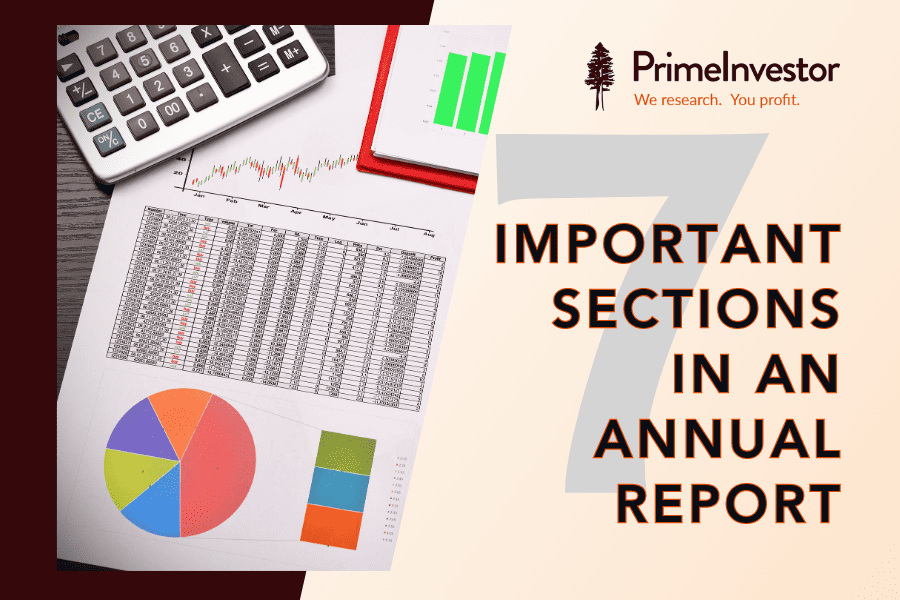A company’s Annual Report is a statutory document that contains material facts and information about the company. This makes it among the most reliable sources for information on a company. For the analyst community, its importance has reduced over time due to regular management conference calls, results presentations, and the continuous stream of information during the year.

But for investors who will find it harder to track such concalls (and who can’t generally participate in them either!), exchange announcements, and so on, the annual report is a valuable document to get insights on the company. This single document gives an investor access to both qualitative and quantitative information which helps in building a good understanding about the prospects of a company. There are even companies of respectable size that do not conduct regular con-calls, but give detailed insights into their business in their annual report.
In this article, we will try to give examples of where in an annual report you can find information that is useful for your understanding of business and financials.
Note: We had written an article on ‘How to read an annual report’ two years ago. Since this topic is an evergreen one, we have updated it with fresh examples to make it more relevant to these times.
Key sections of an annual report
- Chairman’s statement
- 10 Year financial highlights
- Management Discussion & Analysis
- Board’s report
- Corporate governance report
- Auditor’s Report
- Financial Statements
Here, we have broken down the annual report into different sections, explaining what information you can find in each and how it can be useful along with examples. We’ll start with qualitative information and then move to quantitative.
#1 Chairman’s Statement
It is a delicious starter to the wide menu of information that is inside. It gives quick insights on the company’s business and its future. In large business groups, this can be an excellent read. This assumes significance in the case of conglomerates and corporates where there may be significant changes happening which could lead to changes in the overall vision.
For example, for Ambuja Cement, the holding company for ACC as well, the Chairman’s statement from Gautam Adani carries a fresh view of aggression on growth. This was not the case with these companies in the past decade under an MNC ownership. The company was also seeking shareholder approval to infuse Rs.20,000 crore of fresh equity by the group through warrants despite being cash-rich, which also explains the aggression.
M&M Group now has a professional Chairman, Anish Shah, who has been leading the transformation at the group towards profitable growth with target RoCE of 18% across companies. In the case of M&M Financial, he talks about the broader vision, strategy as well as its CEO succession plan beginning FY24 as its long time CEO superannuates in April 2024.
#2 CEO comments/ Q&A
While the Chairman’s statement gives an overall direction, this part will contain the specifics of how the organization is planning to move forward. This also assumes significance in the case of organizations where there are changes underway.
For example, MNC United Spirits (Diageo India) along with unlisted Pernod Ricard owns a lion’s share (~80-85%) of India’s premium liquor market. United Spirits has been embarking on a strategy to undertake slump sale of its mass-market brands and has completed it during FY23. What is left is its premium portfolio of brands. The company gave a detailed Q&A section with its CEO in the annual report on its future strategy.
Bharat Forge’s annual report carries the title “Tonnage and Technology” where the CMD explains how it is transforming from a forging company to a “products and systems” company with verticals such as defense, aerospace, and renewable energy as new focus. He talks about the major pivots that took place in 1990s, early 2000s and now in the 2020s.
#3 Board of Directors
Know the people behind a company when you are first looking up a company in an emerging growth sector, which can be valuable to boost confidence. There will be nominee directors represented by large private equity investors as well. This may open an additional avenue of information, by tracking the performance of companies they have invested in the past. Information such as this can also give some comfort on the kind of leadership and experience a company has access to.
Glance through the annual reports of many of the newly-listed companies and you will find a lot of nominee directors representing private equity investors on the board. But as of now, we are seeing PE players pressing the exit button on their remaining stake in these companies. It should be interesting to watch how the board composition changes from here on.
For a different example, go to the “Board of Directors” section of Aptus Value Housing annual report – there are two nominee directors representing its major PE invest, Westridge Capital, in the company. Piramal Pharma, that was recently demerged and listed, has a nominee director from PE Carlyle.
Nominee directors will also be there in companies that are MNC associates. Take the case of Lumax Industries, a sub Rs.2,000 market cap company with Stanley Electric of Japan directly holding 37.5% stake. The company has a larger board compared to its size and has three nominee directors from Stanley Electric. The profile of Independent Directors is another important thing to look out for when you are looking to invest in smaller companies to build some comfort on the governance aspect.
#4 Management Discussion and Analysis
This section contains a good amount of data and reasoning behind a company’s performance for the year, what the company plans to do, industry, and so on. Based on the depth of the explanations provided in this section, it’s a veritable treasure chest of information. Typically, this section covers the following areas.
Structure of industry
This is in terms of the opportunity size, factors leading/ailing growth, competitive intensity, structural changes that have taken place and so on. This will give you the basics about the industry the company operates in, upon which you can build further through other sources. It makes it easier to understand the company’s performance as well.
Take the case of IT sector. In the last 6 months, we have seen was a complete divergence in earnings performance between mid-cap and large cap players. Most of them deliver specialized services and are an integral part of the transformation unfolding in automobile, industrial, media and telecom sectors.
Similarly, auto sector is seeing a big change in terms of efficiency, driver information and premium features. Lighting, advanced driver information systems, sunroofs, etc. are finding wider acceptance. You can check annual reports of Lumax Industries, Pricol and Asahi Glass for more on these trends and how they will benefit.
Electronics manufacturing has seen a flurry of IPOs recently. Starting with the prominent players such as Dixon and Amber, a reading of annual reports of the newly listed ones may provide an insight into the future of this sunrise industry.
Consumption is another sector that is getting broad-based as well as where premiumization is taking off. The annual report of companies driving premiumization will be insightful to understand how the trend is shaping up.
Business growth
Business growth and factors that have led to growth, or reasons for slack in performance can be found in the MDA. This is specific to each company. It tells you steps the company took to drive growth, giving you an idea about sustainability of that growth. It explains the key events that led to that year’s performance as well. For any growing company, this part of the annual report may give insights to new engines of growth even if they are not separately reportable segments.
For example, IT companies talk about their deal wins in terms of ‘Total Contract Value’ while engineering and capital goods companies or even defence players talk about their ‘Order Book’. You can take cues on how long the Order Book will last, how much it can translate into revenue by doing a rough match of Order Book to Sales or Book to Bill ratio etc.
Even auto component companies have started to publish data on ‘New Order Wins’ for programs like EV which are new to their business. This gives a sense of whether they are gaining traction in new businesses.
Segment-wise information
This is given where companies have varied product/service basket. This helps understand which segment contributes more to growth and profitability and the focus areas for the company.
Engineering player Greaves Cotton received a lot of attention for its diversification to EVs. A sub Rs.2,000 crore revenue company a few years ago, it has clocked Rs.1,000 crore revenue from EV business alone in FY23. This takes the center stage in this year’s annual report and has detailed outlay of its plans in this business.
Piramal Pharma, that saw a lackluster listing in the market post demerger, has released its first annual report. The company caught investor attention for its niche business segments. Its annual report is a must-read on both the qualitative and quantitative sides. The company has a lot of things to get right on both these sides to reward its shareholders.
Other details
Capital expenditure plans provide visibility on whether a company is investing for growth or not. Apart from conventional sectors, renewable energy is one area that is attracting significant capex on the supply side. Amara Raja Batteries has drawn an ambitious capex plan of Rs.9,500 crore in lithium battery manufacturing over an 8-9 year period. The company has given detailed insight into its structured and calibrated approach to this capex plan in its FY23 Annual report under a separate category “New Energy”.
Acquisitions or other business transformation initiatives such as mergers, de-mergers, CEO changes, and so on. Sometimes, you may have to read annual reports for at least 3 years where companies have undergone a significant business transformation, to capture the change.
As FMCG companies become a new home to lot of start-ups from the digital consumer space, Marico is one company that is trying to make big from it. Its new engines of growth such as foods, premium personal care and digital first brands are growing to contribute to 20% of its sales and has detailed takeaways in its annual report. Digital-first brands alone are growing twice or thrice as fast than its conventional business.
V-Guard, a south-based consumer durables player is on the verge of becoming a Rs.5,000 crore revenue company in FY24. For a company that has just around Rs.1,000 crore capital employed in business until FY20, the last 3 years has seen similar amount of fresh capital investment in domestic manufacturing and acquisitions. There is detailed discussion on these in its FY23 annual report and its future strategy.
It is important to take everything you read here with a pinch of salt. Remember that companies will tend to showcase their best performance and plans. Read Annual Reports for at least 3 years to see if the company has been delivering on what it has planned.
#5 Board’s Report
This statutory report provides information on areas including financial performance of subsidiary companies. There are two areas of interest here.
Management Remuneration: This is important in case of family-owned companies where the Board will comprise mainly family members. A check on this section becomes necessary where the promoter stake as well as dividend payout are low. Such issues are less likely in larger companies due to shareholder activism, the rise of proxy advisory firms and tighter regulations recently. Mammoth ESOP rewards of new-age IPO companies have also come under the scanner of proxy advisory firms that advises institutions on voting on resolutions during AGM. Companies like Paytm, Eicher Motors, Bharat Forge, Apollo Tyres, etc. have faced attack from proxy advisory firms on management remuneration. The activism of proxy advisory firms seems to have brought in more rationality on this part.
Related party transactions: This vouches for transparency of transactions between group companies. Related party transactions are not bad on their own, as companies with subsidiaries and associates often engage in several such transactions. But the nature of transactions and the amounts involved matters and where they are not transparent or without good reason, it will help flag governance issues. This is something important to watch in the case of business groups where there are many loss-making businesses at the group level.
For example, the Tata group has been dependent on TCS for long for its capital needs. Since the promoters own a majority stake in TCS, they could take out the cash flows as dividends or buy-backs and then use the resources independently rather than indulging in any related party transactions. In case promoters don’t own majority stake, that is where related party transactions generally crop up.
Britannia Industries, though a well-run business, featured in the news several times over inter-corporate deposits with group companies such as Bombay Burmah and Bombay Dyeing. Rating agencies have also flagged off this as a concern in Britannia. Recently, one of these companies had to take huge write-off post the bankruptcy filing of Go Airlines, a group venture. In the last three years, Britannia has refrained from this practice while paying out dividends as high as 160% and 112% of net profits in FY21 & FY22 while using debt/bonus debentures route for its own capital expenditure plans.
A related party transaction that could take centre stage can be that of Maruti’s proposed acquisition of parent Suzuki Motor Corp’s Gujarat plant, which it announced recently. The board has just approved the proposal and is yet to decide the consideration. This proposal could come up for voting of shareholders in the AGM and Maruti is yet to release its FY23 annual report. The same plant was at the centre of controversy in 2014 while Maruti managed to convince shareholders then.
Now, let’s take the more quantitative sections in the annual report – primarily, the financial statements.
#6 Auditors’ Report
Auditors’ opinion on financial statements is expressed in this section. There will be separate audit reports on standalone and consolidated financial statements. If a company has material subsidiaries which contribute significantly to cashflows, check the opinion of statutory auditor with respect to disclosure of information on such subsidiaries.
However, this section needs to be looked at only in the case of companies that are at the center stage of any controversies. For example, Adani Ports has been under the scanner as its auditor Deloitte issued a qualified opinion regarding the transaction with a few entities mentioned in the Hindenburg report. The Auditor issued a qualified opinion as it could not ascertain whether the entities were related parties or unrelated parties.
#7 Financial Statements
There will be both Standalone and Consolidated statements comprising Balance Sheet, Profit & Loss Account and Cash Flow Statement. While Balance Sheet and P&L will give summary of financial information, detailed information will be available in the Notes to Accounts or Schedules. This is the meat of the financial statements and offers insight into the company’s financials that you will not be able to get from the main P&L or balance sheet.
Below are a few examples of what you can look for in the Notes/schedules to Accounts:
Balance Sheet
There are specific instances which require a detailed check into annual reports. One is to get clarity on items such as “borrowings”. The second is on “investments” and the third is the break-up of items under “other liabilities”. A few examples will explain:
For example, Bharat Forge’s vision statement says the company is eyeing consolidated EBIDTA margins of 20% and RoCE of 20% in its Vision 2030 plan. Prima facie look at the balance sheet may appear like it has too much of debt and receivables in its balance sheet. A detailed check on the break-up of borrowings throws light on various forms of debt including the ‘bill discounting” facilities availed by the company. These items must be adjusted to arrive at numbers on capital employed to calculate RoCE.
Companies in similar business lines may have similar arrangements on the working capital side. If you read the latest financial statements of ACC, you may see sudden changes in cash and other financial assets. Only balance sheet schedules in annual report can provide detailed insights to those. The change in tenure of bank deposits as well as advance payment for procurement of coal (vs paying after purchasing earlier) has led to a change in these items.
Likewise, you may generally get a lumpy figure under “investments”. This may contain strategic investments in companies, other quoted investments, liquid investments in mutual funds, etc. For example, Bharat Forge and Amara Raja have made major strategic investments in EV and battery technology companies, respectively. These are strategic in nature and are grouped under “investments”.
Likewise, fast fashion retailer Trent Ltd has classified its investment (49% stake) in Inditex (ZARA) and Massimo Dutti as financial investments and so not consolidated in its financials.
Bajaj Holdings has close to Rs.10,000 crore investments in other listed companies outside its core investments. It has significant investment in blue chips such as ICICI, HDFC, Reliance, L&T, Infosys, Ultratech and unlisted National Stock Exchange.
Balance Sheet reading may also be extremely useful in case of defence PSUs. They operate under a model where Govt. gives them ‘milestone advances’, which then sets-off against final product purchase. While their balance sheet may appear bloated on ‘receivables’, advances are classified under ‘other liabilities’. One may have to look at both these items to understand the actual extent of receivables. Defence PSU majors are yet to publish their FY-23 annual reports.
Cash flow statement
This is an important statement to look at in the case of new-age companies (their annual reports are yet to be published). While they seem to be reducing the losses from their financial results, the cash flow statement may provide a better insight into how much cash they burn and how much they have in hand. So far only one company, Paytm, has signaled lower cash burn through a small buy-back of equity shares using cash in its balance sheet. Others are still on diversification and growth spree.
A reading of the annual report combining their business plans, capital investment plans and cash flow statement may give a better sense of whether these companies are well-funded to carry out their growth plans without raising fresh capital in a difficult environment.
Defence PSUs is another cohort where one should be keeping a close eye on the cash flow statement. Due to the long gestation of orders and dependence on budgetary allocation, cash flow statement assumes more significant than P&L.
Expense break-ups and other details
The notes to P&L also provide granular details of operating and other expenses, where the P&L would provide only the broad top-level expense outgo. While most of these items may be readily readable from stock screeners and databases, one may go deep into annual reports in case of lack of clarity.
This is only an illustrative article based on our reading of limited number of annual reports for FY23. The stocks mentioned here are not to be taken as our recommendations or our view on potential. Please check Prime Stocks for those we have a Buy call on.




1 thought on “The 7 important sections in an annual report”
Hi Chandra,
This is an excellent summary of key points in Annual Report. While I do basic reading of few points regarding the shares I hold, but now with this article, I will be able to focus more specifically.
While this will help, what I (and may be most of other investors too) will miss is the such key points of major companies. Is it a good idea for PI to open another box to summarise such key points of major companies (say Nifty 50 companies to begin with) for information to all readers. Further the comments on such key points by PI could be another value addition.
Thanks in advance.
Comments are closed.